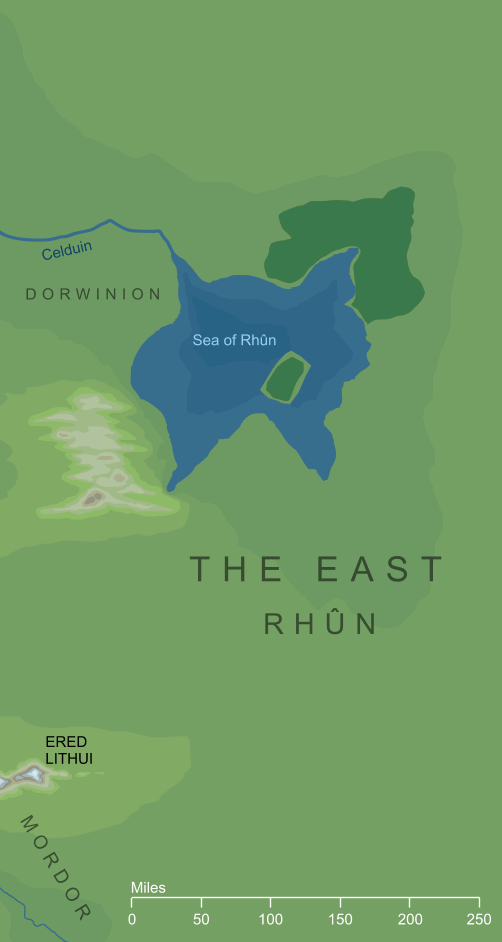- Cities and buildings
- Fields, plains and deserts
- Forests
- Hills and mountains
- Islands and promontories
- Lands, realms and regions
- Rivers and lakes
- Seas and oceans


 |
||||||||
|


Which personality type are you?
Take the Free mydiscprofile Personality Test to discover your core personality and your ideal job.   Which personality type are you? |
|
Dates
The first Elves awoke in this region at Cuiviénen in the distant past; the first Men later awoke in Hildórien in I 1
Location
The wide and little-known eastern lands of Middle-earth
Divisions
The Elves that wandered these lands were of the Avari; Men from this region were referred to collectively as Easterlings
Cultures
Numerous, including Balchoth and Wainriders
Other names
Indexes: About this entry:
|
The EastThe far unknown lands of Middle-earth
The known lands of the East1
The known lands of the East1
A general term for the wild lands that lay out eastward beyond the more populated and civilised western parts of Middle-earth. In the most ancient times, the Elves had awoken in the East in the lakeside region known as Cuiviénen. This was a time of darkness in Middle-earth, and the first Elves came into a world lit only by starlight. At the invitation of the Valar, most of these Elves migrated westward in the Great Journey, but some, known as Avari, continued to wander the wilds of the East. Long afterward, a new race arose in the distant East when the first Men awakened in a land that would become known as Hildórien on the far eastern shores of Middle-earth.1 These early Men were visited by Morgoth, and a darkness lay on their earliest histories, but by no means all were seduced by the Dark Lord. Many migrated westward from Hildórien, some of whom sought for the Light that they had heard could be found in the West. Over generations, Men made the long journey out of the East and crossed the Blue Mountains into Beleriand. These Edain would eventually give rise to the Dúnedain and the kingdom of Númenor. Meanwhile the numbers of Wild Men beyond the Blue Mountains continued to grow, and these Easterlings were for the most part still under the thrall of Morgoth. Many would later enter Beleriand, either fighting directly for the Dark Lord or pretending friendship with the Elves before ultimately betraying them. At the end of the First Age, the War of Wrath caused widespread destruction across Beleriand, and most of that land was consumed by the Sea. During the Second Age, Elves and their allies gradually moved eastward, founding new realms or taking up the rule of older colonies. Thus the wild frontier of the mysterious East was pushed back, so that it came to refer to the region beyond the Misty Mountains and Greenwood the Great. The Elvish name Rhûn, meaning simply 'East', came to be applied to this wide region. Though these lands remained mysterious to Elves and western Men, Sauron extended his power there. He became a Dark Lord over the realms of the Wild Men of the East, and these Men remained his servants until the time of the War of the Ring. Even after Sauron's defeat in the War of the Last Alliance, the Easterlings held to his cruel ways. After about the year III 1000, emissaries from the Valar came to Middle-earth, and three of these Wizards, including Saruman, journeyed into the East. Saruman returned, but the others (named in some sources as Alatar and Pallando) remained there. Whether these Blue Wizards, as they were known, were able to meaningfully resist Sauron's power in the East is unclear (though certain later sources suggest that they were able to foment rebellion among at least some of the Easterlings). Nonetheless, across Gondor's history it was regularly assailed by Easterlings of various kinds, sometimes in alliance with the Haradrim of the South. These Easterlings came under Sauron's direct control once again during the last millennium of the Third Age. The Dark Lord's power had been growing in Dol Guldur in Mirkwood, but when the Wizard Gandalf investigated that stronghold, Sauron retreated into his Eastern domains rather than reveal himself. For the next four centuries - a time known in the Westlands as the Watchful Peace - Sauron remained among the Easterlings, before returning at last to Dol Guldur. In the War of the Ring that brought the Third Age to a close, Sauron called on his Easterling followers for aid, and many of them journeyed to Mordor to join the vast armies he had built there. Even after the Fall of Sauron, some of these Easterlings continued to fight on, but they were ultimately defeated by the Captains of the West. Though their Dark Lord had fallen, the Easterlings who remained in their wide lands continued to hold a hatred of the Gondorians. In the early part of the Fourth Age, Aragorn and Éomer led campaigns far into the East, beyond the Inland Sea known as the Sea of Rhûn. We know little of these eastern wars, but it seems that the Easterlings were ultimately subdued by Gondor and Rohan, and the realms of Middle-earth at last knew peace.2 We can gain some insight into just how far the East extended from a telephone interview given by Tolkien in 1966, which appeared in the fanzine Niekas, issue 18. The interviewer, Henry Resnick, passed on a question from a curious fan: 'What is east of Rhûn and south of Harad?' Tolkien's answer was revealing: 'Rhûn is the Elvish word for 'east'. Asia, China, Japan and all the things which people in the west regard as far away. And south of Harad is Africa, the hot countries.' That is, the East represents the whole of the vast landmass eastward of Europe. (Thanks to Kemal Berk Toy for bringing this reference to our attention.) Notes
See also...Alatar, Aragost, Ash Mountains, Bëorians, Blue Wizards, Borlad, Celebrían, Dark Elves, Dark Lord, East Anórien, Eastlands of Middle-earth, Eglador, Eldar of Hithlum, Elu Thingol, Elves beyond the Sea, [See the full list...] Indexes: About this entry:
For acknowledgements and references, see the Disclaimer & Bibliography page. Original content © copyright Mark Fisher 2020, 2022-2023. All rights reserved. For conditions of reuse, see the Site FAQ. Website services kindly sponsored by Discus from Axiom Software Ltd.The use of the DISC personality test presents a wide range of possibilities when working with teams. |